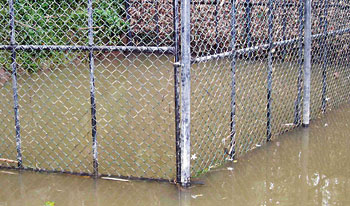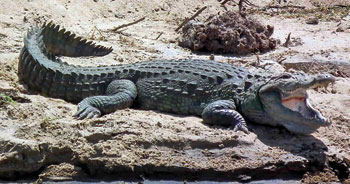They share the same limited resources and this has led to a silent conflict taking place. Man and mugger crocodile vie for a place in the water bodies of the Dry Zone, with the crocodile facing a losing battle.
A preliminary survey conducted last year in over 100 water bodies or reservoirs indicates that over 130 people were attacked with 35 fatalities while more than 50 crocodiles were killed in revenge and as a precaution to prevent future attacks.
Eighty percent of the people were attacked while bathing and washing clothes in tanks, says Anslem de Silva, Vice Chairman, Crocodile Specialist Group IUCN/SSC for South Asia and Iran, stressing that the answer to the human-crocodile conflict is obvious.
Separate human and mugger by giving Crocodile Excluding Enclosures (CEEs) free of charge to extremely needy areas in the dry zone.
This is what Mr. de Silva and Ruchira Somaweera, a Ph.D student at the University of Sydney, Australia, are attempting to do, having secured funds from the Chicago Zoological Society’s Chicago Board of Trade Endangered Species Fund.
In the traditional system of CEEs, people can perform their daily needs safely, says Mr. de Silva, explaining that under the proposed study, they will
- Instal CEEs with the involvement of the vulnerable local people
- Introduce a system to monitor and maintain the setup and
- Increase awareness on the importance of crocodiles and preventing crocodile attacks.
An earlier study in 2008 by Mr. de Silva found that along the Nilwala river and its tributaries in southern Sri Lanka there was a high incidence of saltwater crocodile attacks. However, all attacks were on people who did not use the traditional CEEs. Historically, it is learnt, Sri Lanka had a large population of mugger crocodiles, but during the height of the leather industry in 1920-30s, the species was extensively hunted to the point of near extinction. Nevertheless, since legal protection came into place in 1938, appreciable populations have established, especially within larger reservoirs in the Dry Zone.
With the exponential increase of human populations in the Dry Zone due to large-scale agricultural projects, the number of humans and livestock using these water bodies has also largely increased in the near past. This sharing of an essential, but a limited resource has resulted in an increase of Human Crocodile Conflict.
 |
| A secure metal CEE |
CEEs have been traditionally used by people in the southern Wet Zone where humans frequently use rivers inhabited by saltwater crocodiles, says Mr. de Silva, adding that it is a simple device where three sides are fenced with wooden poles. Given the success of these enclosures in segregating humans and crocodiles and that people in the Dry Zone are unaware of such structures, it is highly possible that the same could be modified and introduced to the tanks in the Dry Zone.
“We plan to establish a set of experimental CEEs, to monitor their benefits and educate the local residents on their use. This could be a simple but effective way of saving lives of humans and livestock and reducing the human-induced mortality of muggers in Sri Lanka,” he says.
Presently the largest wild mugger populations of the world are known from Sri Lanka. However, they are facing a plethora of threats, making the existing populations vulnerable to future depletion. The direct encounter with humans has resulted in a conflict that has resulted in many muggers being killed to make the water sources ‘safe’ for bathing, fishing and other daily needs of humans.
In need of a CEEs?
Anyone who needs a CEE could provide the following information:
a) Name of the water body, locality, approach details
b) Number of bathing places
c) Average number of humans using it per day
d) Number of people who have been attacked by crocodiles
e) Suggest a good place to install the CEEs
f) Name and contact details of the person supplying information
Please contact Anslem de Silva on phone: 071-2748411 or write to A. de Silva, 15/1 Dolosbage Road, Gampola before December 15. |



